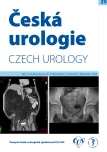REZUM. From the initial idea, through experiments and clinical studies to everyday clinical practice
Authors:
Dalibor Pacík 1,2; Roman Wasserbauer 3; Gabriel Varga 3; Vítězslav Vít 3; Michal Fedorko 3
Authors‘ workplace:
Surgal Clinic, s. r. o., Brno
1; Urologie prof. Pacík, s. r. o., Brno
2; Urologická klinika LF MU, Brno
3
Published in:
Ces Urol 2021; 25(4): 254-262
Category:
Original Articles
Overview
Goal: To evaluate medium term results of treatment of lower urinary tract symptoms (LUTS) due to benign prostatic hyperplasia (BPH) using the REZUM method.
Material and methods: A cohort of patients (N 177) with medium to severe LUTS were treated with the REZUM method from December 2019 until June 2021 and prospectively followed up. Before treatment all patients filled out IPSS and OABv8 questionnaires and underwent uroflometry, transrectal ultrasonography, urine examination and PSA test. These parameters were repeated 3 months and 1 year after procedure and were statistically evaluated.
Results: Evaluation of symptoms after 3 months and one year were finished by 170 patients and 139 patients, respectively. Significant improvement (p < 0.001 was observed in IPSS score after 3 months and one year (median 22 vs 6.9 vs 7), in QoL score (median 4 vs 1.1 vs 1.3), OABv8 (median 17 vs 5.4 vs 6). Significant increase was observed also in Qmax (median 6.9 vs 19 vs 17.3), Qave (median 3,0 vs 9.8 vs 8.9), voided volume (median 170 vs 251 vs 289) and decrease in post voided volume (median 125 vs 0 vs 0). Significant decrease was also observed in prostate volume (median 59 vs 37.2 vs 39) and total PSA (median 2.8 vs 1.9 vs 1.9).
Conclusion: REZUM is a safe and effective method in treatment LUTS due to BPH after one year follow‑up.
Keywords:
Benign prostatic hyperplasia – minimally invasive treatment – REZUM – lower urinary tract symptoms
Sources
1. Barry MJ, Folwer FJ, Jr, O’Leary MP, et al. Measuring disease‑specific health status in men with benign prostatic hyperplasia. Measurement Committee of Mhe American Urological Association. Med Care 1995: 33(Suppl 4): AS 145–155.
2. Dixon Ch, Cedano ER, Pacik D, et al. Efficacy and safety of Rezum system water vapor treatment for lower urinary tract symptoms secondary to benign prostatic hyperplasia. Urology 2015; 86: 1042–1047.
3. Doppalapudi SK, Gupta N. What is new with Rezūm water vapor thermal therapy for LUTS/BPH? Curr Urol Rep. 2021; 22: 4.
4. McVary KT, Gittelman MC, Goldberg KA, et al. Final 5-year outcomes of the multicenter randomized sham‑controlled trial of a water vapor thermal therapy for treatment of moderate to severe lower urinary tract symptoms secondary to benign prostatic hyperplasia. J Urol. 2021; 206: 1–9.
5. Boston Scientific Corporation. Minimally invasive prostatic vapor ablation – multicenter, single arm study for the treatment of BPH in large prostates (Rezūm XL) [Internet]. clinicaltrials.gov; 2020 august [accessed April 18 2021]. Report No.: NCT03605745. Available from https://clinicaltrials.gov/ct2/show/ NCT03605745.
6. Dixon Ch, Cedano ER, Pacik D, et al. Two‑year results after convective water vapor energy treatment of symptomatic benign prostatic hyperplasia. Res Rep Urol 2016; 8: 207–216.
7. McVary KT, Gange SN, Gittelman MC, et al. Erectile and ejaculatory function preserved with convective water vapor energy treatment of lower urinary tract symptoms secondary to benign prostatic hyperplasia: randomized controlled study. J Sex Med 2016; 13: 924–933.
8. McVary KT, Gittelman MC, Goldberg KA, et al. Final 5-year outcomes of the multicenter randomized sham‑controlled trial of a water vapor thermal therapy for treatment of moderate to severe lower urinary tract symptoms secondary to benign prostatic hyperplasia. J Urol. 2021; 206: 1–9.
9. Wasserbauer R, Pacik D, Varga G, Vit V, Jarkovsky J, Fedorko M. Short‑term outcomes of water vapor therapy (Rezūm) for BPH/LUTS in the first Czech cohort. Urology Journal 2021; 18: 6843. https://doi. org/10.22037/uj.v18i.6843 [Epub ahead of print].
10. McVary KT, Roehrborn CG. Three‑year outcomes of the prospective, randomized controlled rezūm system study: convective radiofrequency thermal therapy for treatment of lower urinary tract symptoms due to benign prostatic hyperplasia. Urology 2018; 111: 1–9.
11. Siena G, Cindolo L, Ferrari G, et al. Water vapor therapy (Rezūm) for lower urinary tract symptoms related to benign prostatic hyperplasia: early results from the first Italian multicentric study. World J Urol 2021; 31: 1–6.
12. McVary KT, Holland B, Beahrs JR. Water vapor thermal therapy to alleviate catheter‑dependent urinary retention secondary to benign prostatic hyperplasia. Prostate Cancer Prostatic, DiS. 2020; 23: 303-308.
13. Mollengarden D, Goldberg K, Wong D, Roehrborn C. Convective radiofrequency water vapor thermal therapy for benign prostatic hyperplasia: a single office experience. Prostate Cancer Prostatic, DiS. 2018; 21: 379–385.
Labels
Paediatric urologist Nephrology UrologyArticle was published in
Czech Urology

2021 Issue 4
Most read in this issue
- Serum oncomarkers for prostate cancer
- REZUM. From the initial idea, through experiments and clinical studies to everyday clinical practice
- Retroperitoneal liposarcoma – a case report
- Urogenital system trauma in children and adolescents
